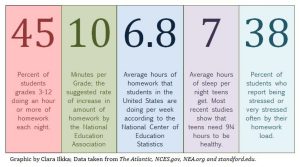Quality over quantity needed in homework for students’ success
Senior Jasmine Allison works on homework in the media center. Students are often overwhelmed by the amount of homework they are given in each class.
It is no secret that American students feel swamped with their homework. While homework is not seen as inherently harmful, most take issue with the sheer amount of homework and its repetitive, unconstructive nature. Many compounding factors have added to this issue, and several solutions can alleviate the brunt of this problem.
Quantity vs. quality of homework
When dissecting the issue of homework, one must look at two of its properties: quantity and quality.
Measuring the quantity of homework is easy and is generally measured by how many hours students spend on it per night. Students who have extracurricular commitments, especially student-athletes, do not appreciate having to cram several hours of homework late at night when they could be spending time with family and friends.
The quality of homework is much more challenging to measure since students and experts disagree on a clear definition of “quality homework.” It is further complicated since students have different learning styles. Some students learn better through visual or audio materials. Others learn better through experiments and projects. And some students learn best through repetition and writing. There is no universal method of teaching that is best suited for all students.
How did we get to today’s homework culture?
The U.S. has gone through periods of more homework and less homework. American teenage students today spend an average of two times as much time on homework as their 1990s counterparts. One major factor in this is an increasing amount of college-level courses offered at the high school level.
According to Assistant Superintendent Jennifer Cherry, high schools only offered one, maybe two, college-level courses. Today, schools often have many that span several departments.
College-level courses equate to college-level homework. When students choose to take multiple Advanced Placement or Postsecondary Enrollment classes, their homework load increases substantially. This workload can shock some students, but college courses in high school hold high students to the same standards as college students.
Even in standard-level high school classes, the homework load has increased due to a significant shift in the teaching profession. In previous decades, teachers had much more autonomy and flexibility over their coursework. However, the quality of education varied greatly from teacher to teacher. So, the U.S. Department of Education decided to standardize teaching across the board having all districts and teachers adhere to set learning standards. More accountability in teaching led to less creative and more repetitive coursework inside and outside the classroom.
What can be done?
When coming up with solutions for this problem, most immediately jump to slashing the amount of homework. That is both unrealistic and not the most effective solution for student success.
Cherry explained that two policies in the District Handbook, Policy 606 and Policy 616, give teachers in the Stillwater School District more freedom, autonomy and creativity than in other school districts. All teachers should take advantage of the independence given to them in the District Handbook to craft innovative homework that fosters long-term retention of subject matter.
Part of the solution requires students to manage their time, given that many teachers at the high school reserve some of their classes as work time. Many students choose to be unproductive, talking with their friends or playing video games on their phones instead of working on homework. Students could cut their outside-of-school homework in half if they commit themselves to work on homework in class.
Homework is not inherently harmful and can benefit learning inside and outside of the classroom. In practice, however, it has become frustrating and overwhelming for students. For students to succeed, homework should enhance the retention of material learned in the classroom.










